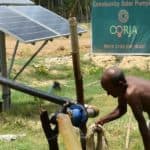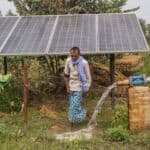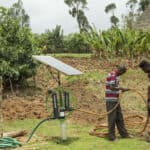Comparing Business Models for Scaling Access to Productive Use of Energy Appliances in Agriculture: The Advantages of Pay-Per-Use
Productive Use of Energy (PUE) appliances are a range of energy-enabled products that, when used by customers, help them to generate additional or new sources of income. Evidence has shown that the use of PUE products drives higher productivity, increased income and improved quality of life. Examples include solar refrigerators, egg incubators, water pumps and electric sewing machines.
PUE is essential for supporting livelihoods in various sectors including agriculture, aquaculture, tailoring, food processing and more. However, challenges like high upfront costs, lack of financing, transportation logistics and poor after-sales service hinder their adoption among vulnerable consumers. This article explores different business and end-user financing models that can support PUE uptake, and focuses on the pay-per-use model pioneered by the farming-as-a-service company Oorja Development Solutions Limited (Oorja) in rural India.
Demand for PUE appliances in agriculture
South Asia and sub-Saharan Africa have large rural populations dependent on agriculture, comprised largely of small and marginal farmers who face economic and social disadvantages. Despite their significant contribution to their countries’ agricultural output and food security, many of these farmers live in poverty, without access to basic services like energy, sanitation, education and healthcare. Furthermore, the heavy reliance of agriculture on rainfall makes these regions highly vulnerable to extreme fluctuations in the weather, which have become more common due to climate change.
Due to these issues, there is growing consumer demand for PUE appliances in agriculture and food production (agri-PUE). Farmers require PUE appliances for various agricultural processes, using devices that range from tractors, sprayers and irrigation pumps to harvesters and agro-processing mills. They also use them for post-harvest needs, employing appliances that include refrigerators, freezers, dryers and equipment for packaging, branding and other types of value addition. Technological innovation has made agri-PUE products more affordable, opening access to a substantial market and creating the potential to transform these farmers’ livelihoods, reducing poverty and mitigating climate change. However, a number of challenges have limited the adoption of PUE products among the consumers most in need.
Challenges to scale in agri-PUE
The cost of agri-PUE is the major barrier to scale, as the upfront capital investment for high ticket-size items such as water pumps is unaffordable to most consumers who earn less than US $100-150 per month. Factoring in farmers’ inability to invest upfront means that the total market size of $11.3 billion for solar water pumps, agro-processing and cooling in sub-Saharan Africa translates into only a $734 million serviceable market, according to the World Bank’s Lighting Global initiative. This means that a large population of farmers in the Global South are forced to rely on expensive and polluting fossil fuels for on-farm energy, adversely impacting their profits while also increasing their carbon footprint. Clean energy PUE products offer a viable alternative with the potential for carbon emissions reduction. But the lack of affordable and accessible financing is preventing the most vulnerable farmers from buying them, even as the global drop in off-grid solar prices is making solar-powered devices the dominant sub-category of PUE.
The market opportunity for agri-PUE is immense, but tapping into it requires that we address these affordability constraints. One solution to this challenge involves business and end-user financing models, which have the potential to enable the uptake of high-impact PUE products by farmers to substantially increase their agricultural productivity, income, food security, nutrition and quality of life. Oorja has leveraged this approach in our innovative Pay-Per-Use business model, through which we aim to increase access to PUE appliances in rural India. This model centers the needs of under-served consumer segments that were left out of direct sales methods. These include low-income users, smallholder farmers, women, Dalit communities and other marginalized groups. These consumers require PUE products or services that are available near them, affordable, of good quality, reliable, with timely maintenance or after-sales service, and suitable for multiple needs at the same time.
Now that we have a fair idea of the demand for PUE appliances and the challenges to scale, we’ll present a case study of the successful use of the pay-per-use model in providing access to decentralized solar infrastructure for agricultural use. We’ll also present other examples of pay-per-use in different geographies, and discuss the potential for this business model to be scaled to millions of consumers — and its potential applicability beyond the agricultural sector in supporting non-farm livelihoods.
Business and end-user financing models to support PUE uptake
Various established and innovative business models and financing schemes are being explored and implemented in the Global South to address challenges in the water-energy-food nexus. These models aim to enhance access to large-scale PUE technologies in the agricultural sector, addressing issues such as farm productivity, fossil fuel reduction, gender inclusion and climate mitigation.
Innovative business and end-user financing models can support the uptake of income-generating appliances among low-income agrarian communities by prioritizing affordability, reliability and proximity to meet the needs of these customer groups within the local agricultural context. Some of the business models and end-user financing schemes currently being used to provide access to PUE technologies include:
Pay-as-you-go (Payg): Consumers pay an initial upfront cost (10-20% of the total) and subsequent regular installments, with ownership transferred once the product is fully paid. This model is suitable for small PUE products and requires credit scores for eligibility.
Subscription model: Consumers pay a recurring fee regardless of their usage, similar to Payg models, but ownership is not necessarily transferred. The implementer (i.e., the company, project or organization that’s providing the appliance) receives steady revenue, which is sufficient to cover the cost of maintenance and upgrades.
Pay-per-use: Consumers only pay for services based on their usage, eliminating the upfront cost barrier for the end user. The implementer finances the capital cost, and operates and maintains the appliance or asset for its full lifetime. The usage charges are lower than current alternatives and include maintenance and operation costs. Unlike in other models, each appliance can be used by a group of consumers, rather than just an individual consumer.
Rental: Consumers rent PUE appliances or assets on an “as-needed” basis — an approach that is typically used for high-cost farming machinery. This model offers flexibility, but may become more expensive than ownership over time.
Cooperative model: Consumers form a group to finance the purchase of PUE appliances through upfront payment and/or bank loans. The group owns the appliances and charges usage fees to non-group members for their use. These usage fees cover maintenance costs and provide additional income to the group.
Pay-by-produce: Consumers pay for PUE appliances with their harvested produce, aligning payments with the crop cycle. The implementer sells a portion of the produce to cover costs, while any surplus is returned to the consumer.
All of these financing models may be able to tap into multiple sources of capital and other support. For instance, in some countries, governments may offer capital subsidies to help consumers afford large-scale PUE devices. But these usually don’t cover the full costs or maintenance of PUE appliances. Beyond subsidies, implementers themselves can seek financing through nonprofit donors, impact investments, crowdfunding or bank loans.
Each of these financing models aims to address affordability constraints, but each has its own challenges and considerations.
For instance, Payg and subscription models have successfully enabled access to household and small agricultural appliances in these communities, but they are not suitable for larger and more expensive PUE products due to their longer repayment periods, which can place a burden on vulnerable households. Rental and cooperative models struggle with after-sales service needs, leading to asset disuse if customers cannot afford repairs. Only the pay-per-use model provides effective maintenance and servicing, with the implementer incentivized to minimize downtime.
The pay-per-use model pioneered by Oorja
Recognizing its unique advantages in serving these communities, Oorja has pioneered the pay-per-use model for three PUE products: solar irrigation pumps, pulverizers for flour and spice milling, and cold storages. These products are in high demand, boost farm income, rely on mature solar technology and require significant investment. All are powered by solar photovoltaic technology, with significant carbon mitigation potential compared to fossil fuels.
Oorja’s target customers are smallholder farmers with less than one acre of land, primarily farmers from disadvantaged communities. We offer irrigation, milling and cooling services at fixed tariffs that are cheaper than diesel-based alternatives. High-cost PUE products, such as solar water pumps, multipurpose pulverizers and solar cold rooms, are made affordable by selling their use as services, removing the upfront acquisition cost through the pay-per-use model.
Oorja uses a careful site selection process involving user demand surveys, and establishes trust with the community before setting up solar infrastructure. Our model relies on a blend of equity and grant capital for initial setup costs. Through this approach, we have successfully provided solar-powered services to 4,000 customers, resulting in reduced expenses, increased crop yields and improved income. The company handles installation, maintenance, insurance and repairs of the solar infrastructure, ensuring high-quality and reliable services. Users have experienced reduced drudgery, along with time savings and greater convenience of on-farm services, contributing to climate resilience and agricultural productivity.
Oorja’s services are priced based on usage at volumetric tariffs that are up to 60% cheaper than diesel-based alternatives. This removes the upfront technology acquisition cost barrier for high-cost PUE products, whose price tag can be quite high. For example:
- Solar water pumps, ranging from 3 to 5 HP capacity, cost $3,000 – $5,000 per system
- Multipurpose pulverizers of 3 to 5 HP capacity cost $500 – $1,000 per appliance (without solar PV)
- Solar cold rooms of 2 to 5 MT capacity cost $10,000 – $16,000 per system
Other pay-per-use and pay-as-you-go pioneers
Other pioneers in the use of pay-per-use and pay-as-you-go models include Aptech Africa, which offers solar-powered irrigation services in Uganda through upfront payment, pay-as-you-go or lease-to-own options. Futurepump and SunCulture implement similar models for low-cost small solar pumps in sub-Saharan Africa. Agsol provides solar-powered agro-processing machinery in East African countries, offering financing through the Payg model. ColdHubs offers solar-powered cooling-as-a-service with pay-as-you-store subscriptions in Nigeria, reducing post-harvest losses. SokoFresh provides farm-level cold storage and market linkage services in Kenya on a pay-per-use basis, benefiting high-value horticultural produce growers. These innovative models have brought social change, economic benefits and increased income to rural communities.
Many of the organizations mentioned above sell micro or small-scale PUE products using the Payg model, often with financing from local financial institutions. They invest in creating agent networks for sales and payment collection. But customers with inconsistent incomes may struggle to pay on time, risking system lockouts. Pay-per-use models, in contrast, offer more flexibility. Customers pay based on service usage without repayment terms or asset ownership. This model is suitable for high-value PUE products that cost over $2,000, unlocking access to solar water pumps, cold rooms and agro-processing mills. Pay-per-use models can also expand access to both PUE and non-energy appliances in agriculture, such as micro-irrigation equipment, farm mechanization tools and agri-processing machinery. They can also apply to non-farm livelihood appliances like sewing machines and power looms.
Conclusion
Cost of technology is the biggest barrier to the uptake of PUE products in the agricultural sector. Pay-as-you-go models have been successful in mainstreaming access to household solar appliances and small agricultural appliances, such as micro solar pumps, though they are not suited for larger products and fail to reach the most low-income customers. And for PUE products costing over $2,000 and with a capacity above 1,000 W, such as water pumps and agri-processing mills, the inability of smallholder farmers to purchase these products even on credit has limited their uptake. Other models struggle with after-sales service needs.
The nascent pay-per-use model, pioneered by Oorja, removes upfront costs, covers maintenance, is highly inclusive and suitable for low-income consumers, and can be applied to various PUE products. Oorja has successfully implemented pay-per-use for solar water pumps, mills and cold storages in rural India. This model can also be used for food processing, animal feed milling, equipment rental, clean cooking and many other types of farm, non-farm, energy and non-energy-related machinery and appliances. Oorja’s pay-per-use model has the potential to be replicated and scaled up globally to enable end-users to increase their agricultural productivity, reduce carbon emissions, become energy-independent, alleviate their poverty and build their climate resilience.
Read Oorja’s report on the inclusive pay-per-use business model to learn more about the model and how Oorja is leveraging it to bridge the access gap for PUE.
Ankur Singh is Senior Manager, Argha Ghose is Communications Associate, and Clementine Chambon is CTO and Co-Founder at Oorja.
Photo: An Oorja customer irrigating his crop. Credit: Oorja
- Categories
- Agriculture, Energy, Finance, Technology



